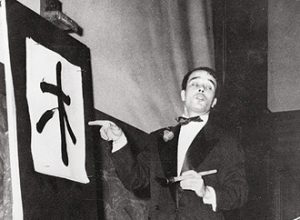
In her last book, De la visibilité. Excellence et singularité en régime médiatique, Nathalie Heinach studied “visibility capital,” which grants a form of superiority to those who possess it. This phenomenon, which was constantly growing in scope throughout the twentieth century, offered her the opportunity to reexamine the notion of the “total social fact,” in Marcel’s Mauss’s sense of the term. Here, she inquires into how the inequality in the status of the artist is to be justified as she flushes out the contradiction inherent to our democratic regime, which oscillates between recognition of excellence and the extolling of equality, aristocratic pride and democratic envy.
Laurence Bertrand Dorléac
Nathalie HeinichOn Artists,
or How Justify Inequality
Not all forms of inequality are necessarily perceived as unjust: to reward students unequally in terms of performances that are themselves unequal appears to us to be equitable; allocating social rights to families in need seems to us to be morally just; respecting a rule of order in a waiting line rather than letting everyone go in at the same time is an indisputable principle of rationality; drawing lots in order to decide who is to begin is a form of convenience accepted even by children. In short, equality is only one of the forms for achieving fairness [l’équité]; in order to satisfy the aspiration for justice, a sense of fairness also grants opportunity as well as unequal distribution according to rank, means, or need.
It remains the case that the inequality of conditions, or social “worth [grandeurs]” can pose a problem in a democratic society, where the aspiration for the equality of (civic and civil) rights as well as equality of opportunity slips easily toward the egalitarian demand for an absolute equality not only of rights and opportunities but also of effectively actual conditions for everyone, an equalization whose historical implementation, let us note, has led to regimes based on terror, whether it be during the French Revolution or under Communist regimes.
In a democratic regime, the tension between the value of equality and the existence of overly prominent forms of inequality or ones ill-tailored to individual merit can be managed in one of two ways: either by denunciation or via justification. We are going to see that the status of the artist in modern Western societies has permitted an embodiment of this second mode—justification of inequalities—first of all through the very special place made for creative artists in the nineteenth century, after the French Revolution, then through the just as special place made for performers in the twentieth century, following the invention of technical means for image reproduction.
Creative Artists in the Nineteenth Century
Post-revolutionary society finds itself divided between contradictory values: between recognition of excellence and glorification of equality, aristocratic “pride” and democratic “envy.” For, the legacy of revolution is not to be measured only by a new mode of exercising power, embodied in the Republic, but also in a new system of values that institute liberty and equality as conditions native to every human being.
Of course, the tension between excellence and equality already existed beforehand, as is testified to by the diversification of ways of entering into the ranks of the elite, a process the French Revolution only accelerated and institutionalized. One of the strongest symbols of this new opening up of possibilities for social mobility was the creation, in 1803, of the French Legion of Honor: in linking excellence to individual abilities and no longer to privileges of birth, it reconciled the elitist principle with the egalitarian principle, thus officializing meritocracy. Divided between faithfulness to the social worth of nobility and democratic principles of de jure citizen equality, the nineteenth century experienced a hesitant cohabitation among several criteria for social worth: birth, landed property, money, knowledge, talent, and competence in maneuvering within high society. How is one to construct a democratic theory of excellence? Here we have the great problem that haunted nineteenth-century society, not only in its political institutions but also, more profoundly, in its axiological principles.
It is this democratic theory of excellence that the Saint-Simonians sought to construct. And it is not an accident that Claude-Henri de Saint-Simon was the first to glorify artists as embodying both the democratic ideal, inasmuch as they accomplish a mission of general interest, and aristocratic excellence, inasmuch as they possess a legitimate superiority—an improbable union that was to be taken up by the propagandists of avant-garde movements, from the mid-nineteenth century to our time.
Artists alone have allowed a dreamed-of reconciliation of these antagonistic values. One example is Victor Hugo who, according to Mona Ozouf’s brief summary description, “brought together in his person the aristocratic singularity of genius and the democratic capacity to be the echo of an entire people.” The artists is he who, in the collective imaginary, unites the democratic aspiration for community with the elitist aspiration for singularity. Every vocation embodies, in effect, a mark of excellence and, at the same time, one of singularity.
This system based on vocation is peculiar also to the scientist and not just to the artist. Both partake in this shift, peculiar to a meritocratic axiology, from having (lands, inherited property, an ancestral name) to doing (an intellectual or artistic work) and, at the same time, from being to doing and from inner life to outer life, which differentiates the creative artist or the genuine thinker from the mere amateur, however passionate the latter might be. Both also embody a certain sort of strangeness, oscillating between bizarre quirkiness and inspired brilliance. But artistic careers, which require less in the way of specific competencies, therefore being more subject to uncertainness, and which aim less at universal knowledge than subjective expressiveness, therefore being less controlled by collective regulations, render singularization, originality, and even marginality more possible. This is the reason why, in Modern Times, creativity in all its forms, much more than scientific invention, has been the privileged target for a system that privileges singularity; and the life of the Bohemian artist, the vocation’s ideal type.
This mixture of aristocratism (excellence is innate), democracy (each has a right to it), and meritocracy (it depends only on individual talent), which defines the status of the artist in the modern era, is admittedly contradictory on the logical level. But compatibility is ensured precisely via the status of the artist, who brings together these different criteria of social worth—a property that seals his success and establishes his power in a democratic society. For, what brings art close to aristocracy is, on the one hand, the innate character of talent (vocation from birth) and, on the other, the fact that privilege would be allocated not only to individuals but to an entire category (artists, creative artists in general); what, conversely, brings it close to democracy is, on the one hand, the linkage of social worth to personal merit (meritocracy) and, on the other hand, everyone’s access to such social worth according to each’s efforts or opportunity; and finally, what distances it as much from aristocratic values as from democratic values is that excellence is defined there in terms of singularity, in the twofold sense of exceptionality (excellence) and marginality (exclusion).
In constituting itself ideally as singular—that is to say, as literally “uncommon”—art pays with its renunciation of power and social integration for its capacity to represent a democratically acceptable privilege, because it is neither aristocratic (no power) nor bourgeois (no integration). Whence the division of the artist into three ideal types, each of which refers to one of these axiological dimensions, combined thus into a chimaera that is as robust as it is improbable: the high-society artist, as embodiment of an aristocracy now relegated to the past; the committed artist, as embodiment of democracy experienced in the present, and the Bohemian artist, as embodiment of a singularity projected into the future. In this way, the three basic substrates of social worth—privilege (aristocracy), merit (democracy), and grace (vocation)—can be conjoined, be it only imaginarily.
Performers in the Twentieth Century
Whether it is a matter of Truth TV [télé-vérité], Reality TV, or, more generally, of televised game shows, television is a tremendous means for promoting the visibility of ordinary citizens who have hardly any particular competency of their own except their capacity to agree to expose in public a more or less consequential part of their image and their life. This is what opens the distribution of visibility-capital toward the lower rungs on the social scale, in the direction of the popular classes that often have hardly any other resources at their disposal and do not have, either, the same codes of discretion and distinction as the more privileged classes do.
The “little people” are therefore increasingly being admitted into the Olympia of famous people—but with serious restrictions on their capacity to enjoy this admittance. By “little people,” one must understand not only those who are impoverished, in money or in culture, but also women, for whom hopes for personal promotion outside of marriage were long limited to the unlikely destinies of queen, national heroine, or saint. It even happens—but here we are reaching the height of paradox—that some physically disadvantaged persons succeed, through television, in raising themselves up to the level of stardom, provided that they are subjected to the judgement not of professionals but of television viewers—the equivalent of what was formerly called “the people”—who, it is probable, project onto someone similar to them in his faults their own desires for glory.
The development of the mass media thus constitutes a tremendous vehicle for increasing one’s hopes that one might approach the world of celebrities—either through the observation of the lives of stars or, also, through the effectively actual possibility of equaling them, at least for a certain period of time. Anyone can therefore hope to become a “hero of the trite and commonplace [la banalité],” according to Serge Tisseron’s phrase, and with some real chances of success, like participants in televised game shows and Reality TV shows. This is what makes the new television celebrity a phenomenon that, if not democratic, is at least clearly less elitist than what such visibility had been at the outset. It is what Graeme Turner calls democratainment, a portmanteau word combining “democracy” and “entertainment.” This is to say that, in relation to the traditional elites of celebrity built upon birth, power, or knowledge, television personalities represent, more than singers or movie actors, a “democratic elite” that perfectly embodies the much-talked-about “American Dream” of the self-made man who has escaped poverty and obscurity to attain the summits of celebrity, prestige, and influence.
But what about an eventual justification for this new, merit-based form of social worth? The philosopher Yves Michaud offers us an enlightening investigation about the different senses of this notion. The democratic regime that was established little by little in postrevolutionary France, was going to make of merit one of its fundamental notions. In the late twentieth century, we arrived at a compromise between “the ideal of merit” and the “reality of acquired advantages and protected statuses.” But the word merit includes two dimensions, as distinguished in English with “to merit” and “to deserve.” This involves a distinction between talent and work, a passive gift and active effort. It is supported by another very old religious duality between two conceptions of what humans “merit,” no longer so much on Earth, which is in the grip of values, but in Heaven, where virtues reign. Here indeed we find again the opposition between the preference of Protestantism for “grace” and that of Catholicism (and still more of the Pelagian current, which is attached to the “power of the will”) for “works.”
There exists, therefore, in the religious heritage of Western culture a marked duality between two principles that allow one to construct an axiology of just reward: merit, which privileges the axiological and political tradition proper to the democratic regime, and grace, which is privileged by a certain kind of religious tradition. While the former is both disclaimed by the present forms of media prestige and yet reaffirmed through its condemnation, does not the latter remain in order to give moral consistency to the social worth of famous people?
In this sense, visibility would be a democratic form of grace granted not by the transcendent authority of divinity but through the celebratory activity of human beings and, among them, those belonging to the most popular circles—the “audience [public]” today having replaced the “people” dear to the proletarian tradition. It must nonetheless be noted that this sociological reversal, which makes of transcendence the product of the immanent activity of those who, as is said, “believe in it,” constitutes a mode of intelligibility that is immediately accessible to today’s cultivated world, stamped with a critical mind, but with few chances of reaching those who, on the other bank, experience fame as a “discretionary grace” nonetheless granted by ever so much more powerful hands than those of all audiences put together, and which they are content to celebrate without ever claiming to be the cause thereof.
That social worth might be given to some, and not to others, neither shocks nor offends their sense of justice. It satisfies their need to admire, all of them together, unreservedly, with fervor and delight. And to say “their,” to speak of “them,” is not to slice society up into two categories—the scientific people and the simple people, the rational ones and the irrational ones—but rather to designate two polarities by which we are all haunted, and into which we all can enter, even though one or the other of them is more familiar to some of us than to others. Grace therefore is the mode of accessing social worth for people who are famous in the eyes of those who first of all take pleasure in recognizing, in all senses of the term (identifying and confirming), rather than in justifying.
It is in this way that the peculiar sort of social worth granted to artists, creative artists in general, and then performers, after the French Revolution and then with the technological revolution in the reproduction of images, was able to be experienced, and continues to be experienced, as a just form of inequality. Either it is justified by some sort of sacrifice (that of social integration) or it transcends all need for justification by fulfilling a need that is undoubtedly just as profound, but decidedly less recognized in the scientific world: the need to admire unreservedly a being who is greater than oneself.
This text borrows elements that have been developed in:
HEINICH, Nathalie. L’Épreuve de la grandeur. Prix littéraires et reconnaissance. Paris: La Découverte, 1999.
HEINICH, Nathalie. L’Elite artiste. Excellence et singularité en régime démocratique. Paris: Gallimard, 2005.
HEINICH, Nathalie. De la visibilité. Excellence et singularité en régime médiatique. Paris: Gallimard, 2012.
Nathalie Heinich, a sociologist, is a research director at the French National Center for Scientific Research (CNRS). Besides numerous articles in scholarly and cultural reviews, she has published works dealing with the status of the artist and the notion of the author (among others: La Gloire de Van Gogh [Paris: Minuit, 1991]; Du peintre à l’artiste [Paris: Minuit, 1993]; Etre écrivain [Paris: La Découverte, 2000]; L’Élite artiste [Paris: Gallimard, 2005]); on contemporary art (among others: Le Triple jeu de l’art contemporain [Paris: Minuit, 1998]); on the question of identity (among others: États de femme [Paris: Gallimard, 1996]; L’Épreuve de la grandeur [Paris: La Découverte, 1999]; Mères-filles, une relation à trois, with Caroline Eliacheff [Paris: Albin Michel, 2002]; Les Ambivalences de l’émancipation féminine [Paris: Albin Michel, 2003]); on the history of sociology (among others: La Sociologie de Norbert Elias [Paris: La Découverte-Repères, 1997]; Ce que l’art fait à la sociologie [Paris: Minuit, 1998]; La Sociologie de l’art [Paris: La Découverte-Repères, 2001]; La Sociologie à l’épreuve de l’art. Entretiens avec Julien Ténédos, 2 vols [La Courneuve: Aux lieux d’être, 2006, 2007]; Pourquoi Bourdieu [Paris: Gallimard, 2007]; Le Bêtisier du sociologue [Paris: Klincksieck, 2009]); and on values (La Fabrique du patrimoine [Paris: Éditions Maison des Sciences de l’Homme, 2009]; De la visibilité. Excellence et singularité en régime médiatique [Paris: Gallimard, 2012]).




